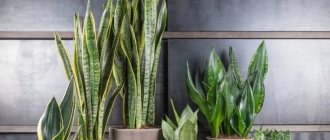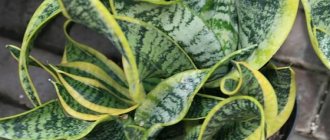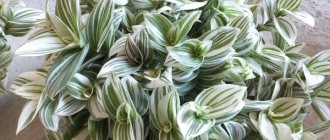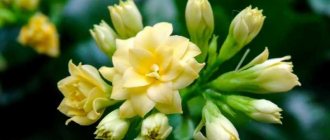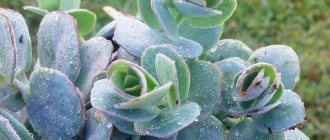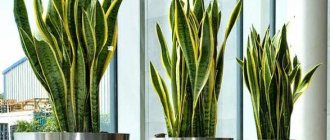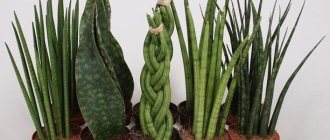- January 2, 2019
- Houseplants
- Suzanna Nyrova
Sansevieria, “pike tail”, is a plant that can withstand almost anything: dry and polluted air, high temperatures and sun, frequent changes in location, lack of water (even a month without watering can cope). The only thing he doesn't like is the soil being too wet. Sansevieria is an interesting decorative variety of indoor flowers with long beautiful leaves. Let's look at how to care for a pike tail flower at home.
Origin
Sansevieria is a genus that includes about 70 species of herbaceous shrubby succulents. This is a plant that originates from the tropical regions of Africa - it can be found around the equator and in the southern part of the continent. It grows in the hot and humid forests of Asia. Grows well in dry and rocky soil and in full sun. The flower was discovered in the mid-18th century by an Italian aristocrat from Naples, Raimondo de Sangro, Prince of San Severo, and the plant's name comes from the name of the place. Its other names, depending on the place of growth, are: “pike tail” flower, “Indian sword”, “wolf tail”, “mother-in-law’s tongue”. This plant is also called “devil’s tongue”, “leopard lily”, “snake skin”, “African hemp”.
Types, names and photos of the “pike tail” flower
Sansevieria are divided into two large groups:
- tall - their height reaches up to 2 meters, they are distinguished by lanceolate leaves;
- low-growing - small plants with straight or curved leaves, growing from a rosette.
The most beautiful and famous varieties are:
- Laurenti is a beautiful plant with gray-green, striped, sword-shaped leaves with a bright rim. The rosette consists of six or more striped leaves. The height of the plant can even exceed one meter.
- Hanni – characterized by shorter stature. It has green, wide, shiny leaves with irregular dark patterns. Reaches a height of 20 cm.
- Golden Honey is a low plant with wide lanceolate leaves with characteristic yellow oblong spots along the edge. Reaches a height of 15 cm.
- Silver Honey is a low plant with a silvery sheen on the leaves, distinguished by dark edging and the presence of transverse stripes.
- Hanni Cristata - with green, wide shiny leaves. Up to 20 cm in height. The second name is African hemp. It can often be seen in medical institutions and offices, as it perfectly purifies the air and eliminates odors.
- Golden Flame is a beautiful indoor flower with yellowish-green leaves. Quite simple and easy to care for.
- Black Gold is a variety with dark green leaves and a yellow edge.
Appearance
The piketail flower is a succulent that can store water in its leaves. It has a creeping rhizome from which fleshy, thick leaves grow. The latter are up to 7 cm wide and usually 40–80 cm high (some reach a length of 1.5 m). The leaves of dwarf varieties are about 15–30 cm long.
“Pike Tail” is a flower with hard, raised, sharp leaves of a dark green color. They are decorated with transverse, irregular stripes and patterns (brighter or darker than the color of the leaves). Some varieties have a cream or yellow-white edge. The leaves grow directly from the soil (from the rhizome), with 2–3 new increments appearing every year. If the plant is properly cultivated, it should bloom in late spring or early summer. It produces a long (30–90 cm) thin rod, at the end of which a branched inflorescence grows. The small, delicate, fragrant flowers are yellow-green or green-white. After flowering, the inflorescence should be removed to prevent fruit formation.
Benefit
The “pike tail” flower, in addition to its decorative qualities, has a number of beneficial health properties:
- purifies the air and eliminates odors;
- plant extract is used in medicine as an anti-inflammatory, choleretic and laxative;
- cut leaves of the plant, like aloe, are used to heal wounds;
- a decoction of the flower is used for infections of the genitourinary system;
- The juice of the plant helps with otitis media.
It is interesting that no matter how much research scientists have conducted, they have not been able to find a single property of a flower that is harmful to humans or animals. On the contrary, the plant is so useful that it is often found not only in apartments, but also in schools, hospitals and other public places.
Beneficial properties of sansevieria
Sansevieria perfectly purifies the air from various harmful impurities. In particular, it effectively removes benzene and trichlorethylene. To significantly improve the environmental situation, only 2-3 medium-sized plants are enough. They can be placed in any room, except the bedroom. Also, the “pike tail” secretes phytoncides that destroy pathogenic microorganisms.
The long leaves of the plant are often called “mother-in-law’s tongue.” According to some superstitions, they encourage people to gossip. In fact, everything is exactly the opposite. Sansevieria has the ability to cleanse the surrounding space of various negativity, helps achieve set goals, and develops entrepreneurship in people.
Potting substrate
The indoor pike tail flower should be planted in a rough environment, it can even be rocky. Experts most often recommend cactus substrate, although equally good results in growing the plant are observed in a mixture of universal potting soil (pH 7.5), compost, sand or perlite. The use of peat should be minimal. The drainage layer should be placed on the bottom of the pot, which will ensure free drainage of excess water.
The following soil mixture can be used for the plant:
- turf – 2 parts;
- leaf soil – 1 part;
- humus – 1 part;
- peat – 1 part;
- sandy soil - 1 part.
Mix all components and place on a drainage layer.
Watering
The home flower “pike tail” is very drought resistant. The plant can withstand up to four weeks without watering. Excessive watering is much more dangerous for it, as a result of which the rhizome and leaves begin to rot (the plant cannot be saved in this case). Sansevieria should be “watered” in the summer once a week or once every two weeks; in winter, watering is limited in accordance with the principle: the colder it is, the less water. Sometimes it is enough to water it every three to four weeks (only when the soil in the pot is visibly dry).
For watering, you can use regular tap water, because Sansevieria loves calcium, and an excess of this element does not harm it. Water for irrigation should be at room temperature. It is best to pour water into the pot stand, and remove excess water, which will prevent rotting of the rhizomes and leaves.
Sansevieria does not tolerate spraying with water. Dust from the leaves should be regularly wiped with a damp cloth, which will improve the appearance of the plant and ensure more efficient photosynthesis. Products used to make houseplants glossy can cause brown or rusty spots to appear on the leaves.
Proper care - water less?
If we remember the harsh conditions of the natural growth of sansevieria, it becomes clear that this is one of the most unpretentious plants, capable of withstanding significant temperature changes, varying light levels and drought.
Important! The only problem for a plant during care can be excessive watering and water getting into the center of the leaf rosettes (especially in winter).
Nevertheless, there are comfortable, acceptable and unacceptable regimes for keeping sansevieria. In particular:
Transfer
Young sansevieria should be replanted every two years, older ones every three years. The new flower pot should have a diameter several centimeters larger than the old one. A layer of drainage 2-3 cm thick is laid on the bottom of the pot (this can be gravel or broken remains of a clay pot). The container must be heavy and durable. A relatively wide clay pot is ideal, because in light and narrow plastic containers a plant with heavy and tall leaves can easily fall, especially in winter when the soil in them is very dry. The pots should also have fairly thick walls, because the roots of the flower grow quickly and intensively, and a fragile container can simply crack under their pressure.
Soil preparation
Sansevierias are replanted once a year, if the plant is still young. If the sansevieria is more than two years old, then the transplant is carried out once every three years. It is best to replant in the spring. The indoor plant has a very extensive root system, so the pot must be selected taking into account the fact that the roots will grow and may begin to destroy the container. In order to prepare the soil for transplanting sansevieria, you need to take four parts of leaf soil, one part of turf soil and one part of sand. It is also possible to add peat or humus. It is necessary to ensure very good drainage for the plant.
Reproduction
The plant can be propagated by cuttings or by dividing the rhizomes. Seedlings are selected in the spring (March - early April); two-year-old leaves are best suited for this. Cut off the leaf at the base and cut it into small pieces (approximately 5-6 cm). The lower part of the seedlings should be immersed in Kornevin for a while and then placed in a container filled with a mixture of sand and peat (1:1 ratio). For one and a half months, the seedlings should be placed in a bright room at a temperature of about +20 ° C, and then transplanted into separate pots.
Newly grown flowers do not replicate the characteristics of the mother plant - no matter what variety was used for propagation, the leaves of the new plant will always be dark green.
If you want to propagate a flower by dividing its rhizome, it is better to do this at the end of summer (September). The plant is carefully removed from the pot and divided into 2-3 parts. Each part should be treated with a fungicide to prevent dangerous diseases. It is necessary to wait a few days for the wounds on the plants to heal, and then transplant them into separate containers. Propagating Sansevieria by dividing the rhizomes ensures that the new plants will be exactly the same as the mother plant.
Application
If the turf meadow is used as a garden decoration, then it harmonizes perfectly with other representatives of the plant world, for example, with the lily family, with irises, with astilbes and buzulniks, etc. Keeping in mind the rapid development of some varieties, you can prune leaves and stems early to achieve a beautiful shape.
Turf pike is often used in folk medicine. As the main component of decoctions and various infusions, this plant in the early stages is able to treat symptoms of colds and flu-like diseases, and also fights skin problems. It is actively used in pharmaceuticals in the manufacture of drugs against ARVI and hepatitis.
Interestingly, long straws can be woven into hats, and can also be used as an internal component of pillows or mattresses.
Problems in growing
The plant is most often affected by the following pests:
- Spider mite - negatively affects the leaves, after which they become pale and begin to dry out. In this case, indoor flowers should be sprayed with an insecticide, and their leaves should be wiped more often with a damp cloth.
- Thrips - create entire colonies on the leaves of the plant, especially on their reverse side. The affected parts are characterized by a gray-brown color. The flower should be treated with insecticide and other chemicals against pests.
- Mealyworms - appear closer to the base of the plant and feed on the sap of the leaves. The affected part bends unnaturally, turns yellow and dies. Powdery mildew can be removed from the flower manually, then wipe all parts of the plant with a damp cloth and spray with karbofos.
In addition to pests, the plant can be attacked by diseases due to improper care.
- If the flower is overfertilized, young leaves become sluggish, weak and soft - then you should stop feeding for some time.
- If the plant is watered too much, brown spots and rot may appear on the leaves. The amount of water used to water the plant should be reduced, and affected leaves should be cut off right next to the rhizome and discarded.
- The leaves of plants that stand on the windowsill may be subject to burns due to strong sunlight (especially in summer). If signs of burn appear on the flower, cut out the damaged parts at the base and move the pot to partial shade.
- Too little lighting causes weaker coloring of the leaves and the disappearance of the decorative stripes and patterns of the plant.
If you like the pike tail flower, caring for it at home will not take much of your time. But Sansevieria will be an excellent decoration for your home.
Plant care
The bush grows very quickly. To give it a neat, beautiful shape, in the spring, at the initial stage of growth, it is necessary to trim the stems and foliage with hedgehog pruners. Otherwise, the hummock may look “gray” due to last year’s old leaves, thereby losing its decorative appearance.
A comfortable temperature is considered to be +25°; higher temperatures have an adverse effect on the plant.
Regular watering is only required for young plants and in very dry weather.
Winding meadow grass, turf pike grass, and Antarctic meadow grass produce a lot of seeds, as a result of which they provoke regular self-seeding, littering the nearest territory. To prevent self-seeding, stems with inflorescences are removed before flowering. As soon as the stems reach 20-30 cm in height, they are cut as close to the soil as possible.
If the bush has become “bald” and unkempt over time, it is dug up or divided into new bushes.
Pike is a cold-season plant: it begins to grow at low spring temperatures and high soil moisture. In summer, when sultry hot weather sets in with temperatures above +25°, the bush falls into dormancy mode. In autumn, when the temperature drops and the rainy season begins, the meadow grass “wakes up” and begins to grow again.
Pike in spring
Lighting
For regular growth, development and abundant flowering, the plant must choose a well-lit place. In shade and partial shade, the bush is able to grow actively, but due to lack of lighting, the plant rarely blooms.
The soil
The plant is unpretentious and undemanding to the soil, capable of growing on any soil composition. However, when organic and mineral fertilizers are applied, its decorative properties only improve: the bush actively responds with a lush, elegant green mass and abundant flowering.
